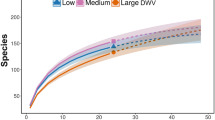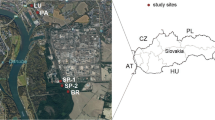Abstract
The data collected during nine vegetation seasons were analysed to reveal abundance of the common shrew in fir-beech forests of the Kremnické vrchy Mts. (Western Carpathians, central Slovakia). Live trapping in three quadratic study plots and five lines representing different age categories of fir-beech and beech forests was carried out using wooden live traps and pitfalls. A very low abundance of the common shrew was found. During the whole period, the absolute overall trapping efficiency of the species comprised only 0.07% and mean density 0.08–0.52 ind./ha. The analysis revealed significant differences in neither trapping efficiency nor density among the study plots. Pitfalls and Chmela live traps reached similar values of the trapping efficiency (0.06 vs. 0.07%). The regression model showed a significant relationship (r = 0.55, p < 0.05) between the number of trap nights and the number of trapped individuals of the common shrew, but the overall number of trapped individuals remained very low also on the level of high trapping intensity. Some causes of the very low abundance of the common shrew were discussed; the fact remains a real rarity of the species in the given area and time.



Similar content being viewed by others
References
Amori G, Locasciulli O, Luiselli L (2011) Non-random distribution across habitat types in sympatric, hardly catchable small mammals at a mouintainous site in central Italy. Rend Fis Acc Lincei 22:17–23. doi:10.1007/s12210-010-0108-y
Anděra M (2010) Current distributional status of insectivores in the Czech Republic (Eulipotyphla). Lynx, n. s. (Praha) 41:15–63
Baláž I, Ambros M (2005a) Biology, ecology and distribution of the genus Sorex in Slovakia. FPV UKF, Nitra
Baláž I, Ambros M (2005b) Relationship of shrews (Sorex sp.) to forest biotopes in Western Carpathians. Ekológia (Bratislava) 24:254–262
Barti L (2011) Unusual occurrence of the Bicoloured white-toothed shrew (Crocidura leucodon, Soricomorpha: Soricidae) in a mature beech forest in the Ciomad-Puturosu Mountains (Eastern Carpathians, Central Romania). Acta Siculica 2011:119–124
Bogdziewicz M, Zwolak R (2014) Responses of small mammals to clear-cutting in temperate and boreal forests of Europe: a meta-analysis and review. Eur J Forest Res 133:1–11. doi:10.1007/s10342-013-0726-x
Canova L, Fasola M (1991) Communities of small mammals in six biotopes of northern Italy. Acta Theriol 36:73–86
Churchfield S (1990) The natural history of shrews. Christopher Helm, London
Churchfield S, Hollier J, Brown V (1995) Population dynamics and survivorship patterns in the common shrew Sorex araneus in southern England. Acta Theriol 40:53–68
Dudich A (1986) Siphonaptera, Insecta—ectoparasites of small terrestrial mammals in the Protected Landscape Area Muránska Planina. Ochrana Prírody 7:149–168
Dudich A (1987) A study of Siphonaptera, Insecta of the small terrestrial mammals in the Kremnica hills (Western Carpathians). Kmetianum 8:333–350
Dudich A, Štollmann A (1981) Repeated research of small terrestrial mammals in the Badín primeval forest. Zborník lesníckeho, drevárskeho a poľovníckeho múzea v Antole 11:249–265
Dudich A, Štollmann A (1985) Pitfall traps and their efficiency from the aspect of investigating the fauna of small mammals. Biológia Bratislava 40:1049–1054
Hice L, Velazco PM (2013) Relative effectiveness of several bait and trap types for assessing terrestrial small mammal communities in neotropical rainforest. Mus Texas Tech University Occas Papers Number 213:1–15
Hlôška L, Saniga M (2005) Community structure of small mammals (Insectivora, Rodentia) in the Kľačianska Magura National Nature Reserve (Malá Fatra Mts., Western Carpathians). Folia Oecol 32:59–67
Jand Zukal, Gaisler J (1992) Testing of a new method of sampling small mammal communities. Folia Zool 41:299–310
Jurík M (1960) Aphaniptera of small mammals of the Badín primeval forest (Kremnica Mts.). Biológia Bratislava 15:847–849
Kalko EKV, Handley CO Jr (1993) Comparative studies of small mammal populations with transects of snap traps and pitfall arrays in southwest Virginia. Va J Sci 44:1–18
Krištofík J, Danko Š et al (2012) Mammals of Slovakia, distribution, bionomy and protection. VEDA, Bratislava
Laakkonen J, Fisher RN, Case TJ (2003) Factor influencing the variation in capture rates of shrews in southern California, USA. Acta Theriol 48:157–166
Lešo P, Kropil R (2010) Influence of some methodological modifications on trapping efficiency and mortality of small terrestrial mammals (Rodentia). Lynx, n. s. 41:167–173
Lešo P, Lešová A, Kropil R (2014) Influence of forest fragmentation on the distribution of small terrestrial mammals in fir-beech commercial forest. J For Sci 60:24–329
Lešo P, Lešová A, Kropil R, Kaňuch P (2016) Response of the dominant rodent species to close-tonature logging practices in a temperate mixed forest. Ann For Res. doi:10.15287/afr.2016.620
Mitchell-Jones AJ, Amori G, Bogdanowicz W, Kryštufek B, Reijnders PJH, Spitzenberger F, Stubbe M, Thissen JBM, Vohralík V, Zima J (1999) The Atlas of European Mammals. Academic Press, London
Mortelliti A, Amori G, Sammuri G, Boitani L (2007) Factors affecting the distribution of Sorex samniticus, an endemic Italian shrew, in an heterogeneous landscape. Acta Theriol 52:75–84
Nedeljak F (1962) Small mammals of the Badín primeval forest. Biológia Bratislava 17:130–142
Pelikán J (1975) On the standardization of the trapping quadrat and line for estimating the population density of small mammals in forests. Lynx n. s. 17:58–71
Pelikán J, Zejda J, Holišová V (1977) Efficiency of different traps in catching small mammals. Folia Zool 26:1–13
Rychlik L (2000) Habitat preferences of four sympatric species of shrews. Acta Theriol 45(Suppl. 1):173–190
Spinozzi F, Battisti C, Bologna MA (2012) Habitat fragmentation sensitivity in mammals: a target selection for landscape planning comparing two different approaches (bibliographic review and expert based). Rend Fis Acc Lincei 23:365–373. doi:10.1007/s12210-012-0184-2
Stanko M, Mošanský L, Fričová J, Casanova JC (1999) Comparison of two sampling methods of small mammals in the margin of a lowland forest. Biologia Bratislava 54:595–597
StatSoft, Inc. (2011) STATISTICA for Windows. Tulsa
Štollmann A, Dudich A (1983) Small terrestrial mammals of the Ľubochnianska valley in the Veľká Fatra Mts. Ochrana Prírody 4:153–177
Štollmann A, Dudich A (1985) Insectivores (Insectivora) and rodents (Rodentia) of the Protected Landscape Area Poľana. Ochrana Prírody 6:265–279
Suchomel J, Čepelka L, Purchart L (2012) Small mammals at forest plantations in the Jeseníky Mts. (Czech Republic). Acta Universitatis Agriculturae et Silviculturae Mendelianae Brunensis 60(5):211–218
Suchomel J, Purchart L, Čepelka L, Heroldová M (2014) Structure and diversity of small mammal communities of mountain forests in Western Carpathians. Eur J For Res 133:481–490. doi:10.1007/s10342-013-0778-y
Uhrin M, Benda P, Ambros M, Baláž I, Dudich A, Hapl E, Reiter A, Stollmann A (2009) On the fauna of insectivores (Erinaceomorpha, Soricomorpha) and rodents (Rodentia) of the Muránska planina National Park and its surroundings (central Slovakia). Lynx, n. s. (Praha), 40:95–114
Whittaker JC, Feldhamer GA (2000) Effectiveness of three live trap types for Blarina (Insectivora: Soricidae) and description of a new trap design. Mammalia 64:118–124
Woodman N, Timm RM, Slade NA, Doonan TJ (1996) Comparison of traps and baits for censuing small mammals in Neotropical lowlands. J Mammal 77:274–281
Zbytovský P and Anděra M (2011) Small terrestrial mammals of the northern parts of the Českomoravská vrchovina Highland, Czech Republic (Eulipotyphla, Rodentia). Lynx, n. s. (Praha), 42:197–266
Zbytovský P, Anděra M, Hanák V (2004) Small mammals of the southern parts of the Českomoravska vrchovina Highland (Insectivora, Chiroptera, Rodentia). Lynx (Praha), n. s., 35:141–245
Zlatník A (1959) A survey of Slovak forests according to the forest type groups. Spisy Vědecké laboratoře biogeocenologie a typologie lesa, VŠZ Brno 3:1–195
Zub K, Jedrzejewska B, Jedrzejewski W, Bartoń KA (2012) Cyclic voles and shrews and non-cyclic mice in a marginal grassland within European temperate forest. Acta Theriol 57:205–216. doi:10.1007/s13364-012-0072-2
Acknowledgements
This contribution is the result of implementing the projects “Centre of Excellence: Adaptive Forest Ecosystems” (ITMS 26220120006) and “Completing the Centre of Excellence: Adaptive Forest Ecosystems” (ITMS 26220120049) supported by the Operational Programme Research and Development within the European Regional Development Fund. This work was also supported by the Slovak Research and Development Agency under the Contract No. APVV-14-0637. We thank to the Forestry School Enterprise of the Technical University in Zvolen for providing the field station, Pavel Gibas for his help in the field, Jana Luptáková for revising English, and anonymous reviewers for improving the manuscript.
Author information
Authors and Affiliations
Corresponding author
Rights and permissions
About this article
Cite this article
Lešo, P., Kropil, R. Is the common shrew (Sorex araneus) really a common forest species?. Rend. Fis. Acc. Lincei 28, 183–189 (2017). https://doi.org/10.1007/s12210-016-0590-y
Received:
Accepted:
Published:
Issue Date:
DOI: https://doi.org/10.1007/s12210-016-0590-y




